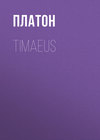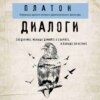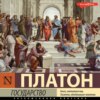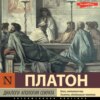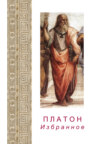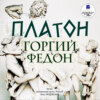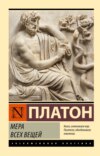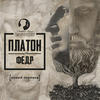Читать книгу: «Timaeus»
INTRODUCTION AND ANALYSIS
Of all the writings of Plato the Timaeus is the most obscure and repulsive to the modern reader, and has nevertheless had the greatest influence over the ancient and mediaeval world. The obscurity arises in the infancy of physical science, out of the confusion of theological, mathematical, and physiological notions, out of the desire to conceive the whole of nature without any adequate knowledge of the parts, and from a greater perception of similarities which lie on the surface than of differences which are hidden from view. To bring sense under the control of reason; to find some way through the mist or labyrinth of appearances, either the highway of mathematics, or more devious paths suggested by the analogy of man with the world, and of the world with man; to see that all things have a cause and are tending towards an end – this is the spirit of the ancient physical philosopher. He has no notion of trying an experiment and is hardly capable of observing the curiosities of nature which are 'tumbling out at his feet,' or of interpreting even the most obvious of them. He is driven back from the nearer to the more distant, from particulars to generalities, from the earth to the stars. He lifts up his eyes to the heavens and seeks to guide by their motions his erring footsteps. But we neither appreciate the conditions of knowledge to which he was subjected, nor have the ideas which fastened upon his imagination the same hold upon us. For he is hanging between matter and mind; he is under the dominion at the same time both of sense and of abstractions; his impressions are taken almost at random from the outside of nature; he sees the light, but not the objects which are revealed by the light; and he brings into juxtaposition things which to us appear wide as the poles asunder, because he finds nothing between them. He passes abruptly from persons to ideas and numbers, and from ideas and numbers to persons, – from the heavens to man, from astronomy to physiology; he confuses, or rather does not distinguish, subject and object, first and final causes, and is dreaming of geometrical figures lost in a flux of sense. He contrasts the perfect movements of the heavenly bodies with the imperfect representation of them (Rep.), and he does not always require strict accuracy even in applications of number and figure (Rep.). His mind lingers around the forms of mythology, which he uses as symbols or translates into figures of speech. He has no implements of observation, such as the telescope or microscope; the great science of chemistry is a blank to him. It is only by an effort that the modern thinker can breathe the atmosphere of the ancient philosopher, or understand how, under such unequal conditions, he seems in many instances, by a sort of inspiration, to have anticipated the truth.
The influence with the Timaeus has exercised upon posterity is due partly to a misunderstanding. In the supposed depths of this dialogue the Neo-Platonists found hidden meanings and connections with the Jewish and Christian Scriptures, and out of them they elicited doctrines quite at variance with the spirit of Plato. Believing that he was inspired by the Holy Ghost, or had received his wisdom from Moses, they seemed to find in his writings the Christian Trinity, the Word, the Church, the creation of the world in a Jewish sense, as they really found the personality of God or of mind, and the immortality of the soul. All religions and philosophies met and mingled in the schools of Alexandria, and the Neo-Platonists had a method of interpretation which could elicit any meaning out of any words. They were really incapable of distinguishing between the opinions of one philosopher and another – between Aristotle and Plato, or between the serious thoughts of Plato and his passing fancies. They were absorbed in his theology and were under the dominion of his name, while that which was truly great and truly characteristic in him, his effort to realize and connect abstractions, was not understood by them at all. Yet the genius of Plato and Greek philosophy reacted upon the East, and a Greek element of thought and language overlaid and partly reduced to order the chaos of Orientalism. And kindred spirits, like St. Augustine, even though they were acquainted with his writings only through the medium of a Latin translation, were profoundly affected by them, seeming to find 'God and his word everywhere insinuated' in them (August. Confess.)
There is no danger of the modern commentators on the Timaeus falling into the absurdities of the Neo-Platonists. In the present day we are well aware that an ancient philosopher is to be interpreted from himself and by the contemporary history of thought. We know that mysticism is not criticism. The fancies of the Neo-Platonists are only interesting to us because they exhibit a phase of the human mind which prevailed widely in the first centuries of the Christian era, and is not wholly extinct in our own day. But they have nothing to do with the interpretation of Plato, and in spirit they are opposed to him. They are the feeble expression of an age which has lost the power not only of creating great works, but of understanding them. They are the spurious birth of a marriage between philosophy and tradition, between Hellas and the East – (Greek) (Rep.). Whereas the so-called mysticism of Plato is purely Greek, arising out of his imperfect knowledge and high aspirations, and is the growth of an age in which philosophy is not wholly separated from poetry and mythology.
A greater danger with modern interpreters of Plato is the tendency to regard the Timaeus as the centre of his system. We do not know how Plato would have arranged his own dialogues, or whether the thought of arranging any of them, besides the two 'Trilogies' which he has expressly connected; was ever present to his mind. But, if he had arranged them, there are many indications that this is not the place which he would have assigned to the Timaeus. We observe, first of all, that the dialogue is put into the mouth of a Pythagorean philosopher, and not of Socrates. And this is required by dramatic propriety; for the investigation of nature was expressly renounced by Socrates in the Phaedo. Nor does Plato himself attribute any importance to his guesses at science. He is not at all absorbed by them, as he is by the IDEA of good. He is modest and hesitating, and confesses that his words partake of the uncertainty of the subject (Tim.). The dialogue is primarily concerned with the animal creation, including under this term the heavenly bodies, and with man only as one among the animals. But we can hardly suppose that Plato would have preferred the study of nature to man, or that he would have deemed the formation of the world and the human frame to have the same interest which he ascribes to the mystery of being and not-being, or to the great political problems which he discusses in the Republic and the Laws. There are no speculations on physics in the other dialogues of Plato, and he himself regards the consideration of them as a rational pastime only. He is beginning to feel the need of further divisions of knowledge; and is becoming aware that besides dialectic, mathematics, and the arts, there is another field which has been hitherto unexplored by him. But he has not as yet defined this intermediate territory which lies somewhere between medicine and mathematics, and he would have felt that there was as great an impiety in ranking theories of physics first in the order of knowledge, as in placing the body before the soul.
It is true, however, that the Timaeus is by no means confined to speculations on physics. The deeper foundations of the Platonic philosophy, such as the nature of God, the distinction of the sensible and intellectual, the great original conceptions of time and space, also appear in it. They are found principally in the first half of the dialogue. The construction of the heavens is for the most part ideal; the cyclic year serves as the connection between the world of absolute being and of generation, just as the number of population in the Republic is the expression or symbol of the transition from the ideal to the actual state. In some passages we are uncertain whether we are reading a description of astronomical facts or contemplating processes of the human mind, or of that divine mind (Phil.) which in Plato is hardly separable from it. The characteristics of man are transferred to the world-animal, as for example when intelligence and knowledge are said to be perfected by the circle of the Same, and true opinion by the circle of the Other; and conversely the motions of the world-animal reappear in man; its amorphous state continues in the child, and in both disorder and chaos are gradually succeeded by stability and order. It is not however to passages like these that Plato is referring when he speaks of the uncertainty of his subject, but rather to the composition of bodies, to the relations of colours, the nature of diseases, and the like, about which he truly feels the lamentable ignorance prevailing in his own age.
We are led by Plato himself to regard the Timaeus, not as the centre or inmost shrine of the edifice, but as a detached building in a different style, framed, not after the Socratic, but after some Pythagorean model. As in the Cratylus and Parmenides, we are uncertain whether Plato is expressing his own opinions, or appropriating and perhaps improving the philosophical speculations of others. In all three dialogues he is exerting his dramatic and imitative power; in the Cratylus mingling a satirical and humorous purpose with true principles of language; in the Parmenides overthrowing Megarianism by a sort of ultra-Megarianism, which discovers contradictions in the one as great as those which have been previously shown to exist in the ideas. There is a similar uncertainty about the Timaeus; in the first part he scales the heights of transcendentalism, in the latter part he treats in a bald and superficial manner of the functions and diseases of the human frame. He uses the thoughts and almost the words of Parmenides when he discourses of being and of essence, adopting from old religion into philosophy the conception of God, and from the Megarians the IDEA of good. He agrees with Empedocles and the Atomists in attributing the greater differences of kinds to the figures of the elements and their movements into and out of one another. With Heracleitus, he acknowledges the perpetual flux; like Anaxagoras, he asserts the predominance of mind, although admitting an element of necessity which reason is incapable of subduing; like the Pythagoreans he supposes the mystery of the world to be contained in number. Many, if not all the elements of the Pre-Socratic philosophy are included in the Timaeus. It is a composite or eclectic work of imagination, in which Plato, without naming them, gathers up into a kind of system the various elements of philosophy which preceded him.
If we allow for the difference of subject, and for some growth in Plato's own mind, the discrepancy between the Timaeus and the other dialogues will not appear to be great. It is probable that the relation of the ideas to God or of God to the world was differently conceived by him at different times of his life. In all his later dialogues we observe a tendency in him to personify mind or God, and he therefore naturally inclines to view creation as the work of design. The creator is like a human artist who frames in his mind a plan which he executes by the help of his servants. Thus the language of philosophy which speaks of first and second causes is crossed by another sort of phraseology: 'God made the world because he was good, and the demons ministered to him.' The Timaeus is cast in a more theological and less philosophical mould than the other dialogues, but the same general spirit is apparent; there is the same dualism or opposition between the ideal and actual – the soul is prior to the body, the intelligible and unseen to the visible and corporeal. There is the same distinction between knowledge and opinion which occurs in the Theaetetus and Republic, the same enmity to the poets, the same combination of music and gymnastics. The doctrine of transmigration is still held by him, as in the Phaedrus and Republic; and the soul has a view of the heavens in a prior state of being. The ideas also remain, but they have become types in nature, forms of men, animals, birds, fishes. And the attribution of evil to physical causes accords with the doctrine which he maintains in the Laws respecting the involuntariness of vice.
The style and plan of the Timaeus differ greatly from that of any other of the Platonic dialogues. The language is weighty, abrupt, and in some passages sublime. But Plato has not the same mastery over his instrument which he exhibits in the Phaedrus or Symposium. Nothing can exceed the beauty or art of the introduction, in which he is using words after his accustomed manner. But in the rest of the work the power of language seems to fail him, and the dramatic form is wholly given up. He could write in one style, but not in another, and the Greek language had not as yet been fashioned by any poet or philosopher to describe physical phenomena. The early physiologists had generally written in verse; the prose writers, like Democritus and Anaxagoras, as far as we can judge from their fragments, never attained to a periodic style. And hence we find the same sort of clumsiness in the Timaeus of Plato which characterizes the philosophical poem of Lucretius. There is a want of flow and often a defect of rhythm; the meaning is sometimes obscure, and there is a greater use of apposition and more of repetition than occurs in Plato's earlier writings. The sentences are less closely connected and also more involved; the antecedents of demonstrative and relative pronouns are in some cases remote and perplexing. The greater frequency of participles and of absolute constructions gives the effect of heaviness. The descriptive portion of the Timaeus retains traces of the first Greek prose composition; for the great master of language was speaking on a theme with which he was imperfectly acquainted, and had no words in which to express his meaning. The rugged grandeur of the opening discourse of Timaeus may be compared with the more harmonious beauty of a similar passage in the Phaedrus.
To the same cause we may attribute the want of plan. Plato had not the command of his materials which would have enabled him to produce a perfect work of art. Hence there are several new beginnings and resumptions and formal or artificial connections; we miss the 'callida junctura' of the earlier dialogues. His speculations about the Eternal, his theories of creation, his mathematical anticipations, are supplemented by desultory remarks on the one immortal and the two mortal souls of man, on the functions of the bodily organs in health and disease, on sight, hearing, smell, taste, and touch. He soars into the heavens, and then, as if his wings were suddenly clipped, he walks ungracefully and with difficulty upon the earth. The greatest things in the world, and the least things in man, are brought within the compass of a short treatise. But the intermediate links are missing, and we cannot be surprised that there should be a want of unity in a work which embraces astronomy, theology, physiology, and natural philosophy in a few pages.
It is not easy to determine how Plato's cosmos may be presented to the reader in a clearer and shorter form; or how we may supply a thread of connexion to his ideas without giving greater consistency to them than they possessed in his mind, or adding on consequences which would never have occurred to him. For he has glimpses of the truth, but no comprehensive or perfect vision. There are isolated expressions about the nature of God which have a wonderful depth and power; but we are not justified in assuming that these had any greater significance to the mind of Plato than language of a neutral and impersonal character… With a view to the illustration of the Timaeus I propose to divide this Introduction into sections, of which the first will contain an outline of the dialogue: (2) I shall consider the aspects of nature which presented themselves to Plato and his age, and the elements of philosophy which entered into the conception of them: (3) the theology and physics of the Timaeus, including the soul of the world, the conception of time and space, and the composition of the elements: (4) in the fourth section I shall consider the Platonic astronomy, and the position of the earth. There will remain, (5) the psychology, (6) the physiology of Plato, and (7) his analysis of the senses to be briefly commented upon: (8) lastly, we may examine in what points Plato approaches or anticipates the discoveries of modern science.
Section 1
Socrates begins the Timaeus with a summary of the Republic. He lightly touches upon a few points, – the division of labour and distribution of the citizens into classes, the double nature and training of the guardians, the community of property and of women and children. But he makes no mention of the second education, or of the government of philosophers.
And now he desires to see the ideal State set in motion; he would like to know how she behaved in some great struggle. But he is unable to invent such a narrative himself; and he is afraid that the poets are equally incapable; for, although he pretends to have nothing to say against them, he remarks that they are a tribe of imitators, who can only describe what they have seen. And he fears that the Sophists, who are plentifully supplied with graces of speech, in their erratic way of life having never had a city or house of their own, may through want of experience err in their conception of philosophers and statesmen. 'And therefore to you I turn, Timaeus, citizen of Locris, who are at once a philosopher and a statesman, and to you, Critias, whom all Athenians know to be similarly accomplished, and to Hermocrates, who is also fitted by nature and education to share in our discourse.'
HERMOCRATES: 'We will do our best, and have been already preparing; for on our way home, Critias told us of an ancient tradition, which I wish, Critias, that you would repeat to Socrates.' 'I will, if Timaeus approves.' 'I approve.' Listen then, Socrates, to a tale of Solon's, who, being the friend of Dropidas my great-grandfather, told it to my grandfather Critias, and he told me. The narrative related to ancient famous actions of the Athenian people, and to one especially, which I will rehearse in honour of you and of the goddess. Critias when he told this tale of the olden time, was ninety years old, I being not more than ten. The occasion of the rehearsal was the day of the Apaturia called the Registration of Youth, at which our parents gave prizes for recitation. Some poems of Solon were recited by the boys. They had not at that time gone out of fashion, and the recital of them led some one to say, perhaps in compliment to Critias, that Solon was not only the wisest of men but also the best of poets. The old man brightened up at hearing this, and said: Had Solon only had the leisure which was required to complete the famous legend which he brought with him from Egypt he would have been as distinguished as Homer and Hesiod. 'And what was the subject of the poem?' said the person who made the remark. The subject was a very noble one; he described the most famous action in which the Athenian people were ever engaged. But the memory of their exploits has passed away owing to the lapse of time and the extinction of the actors. 'Tell us,' said the other, 'the whole story, and where Solon heard the story.' He replied – There is at the head of the Egyptian Delta, where the river Nile divides, a city and district called Sais; the city was the birthplace of King Amasis, and is under the protection of the goddess Neith or Athene. The citizens have a friendly feeling towards the Athenians, believing themselves to be related to them. Hither came Solon, and was received with honour; and here he first learnt, by conversing with the Egyptian priests, how ignorant he and his countrymen were of antiquity. Perceiving this, and with the view of eliciting information from them, he told them the tales of Phoroneus and Niobe, and also of Deucalion and Pyrrha, and he endeavoured to count the generations which had since passed. Thereupon an aged priest said to him: 'O Solon, Solon, you Hellenes are ever young, and there is no old man who is a Hellene.' 'What do you mean?' he asked. 'In mind,' replied the priest, 'I mean to say that you are children; there is no opinion or tradition of knowledge among you which is white with age; and I will tell you why. Like the rest of mankind you have suffered from convulsions of nature, which are chiefly brought about by the two great agencies of fire and water. The former is symbolized in the Hellenic tale of young Phaethon who drove his father's horses the wrong way, and having burnt up the earth was himself burnt up by a thunderbolt. For there occurs at long intervals a derangement of the heavenly bodies, and then the earth is destroyed by fire. At such times, and when fire is the agent, those who dwell by rivers or on the seashore are safer than those who dwell upon high and dry places, who in their turn are safer when the danger is from water. Now the Nile is our saviour from fire, and as there is little rain in Egypt, we are not harmed by water; whereas in other countries, when a deluge comes, the inhabitants are swept by the rivers into the sea. The memorials which your own and other nations have once had of the famous actions of mankind perish in the waters at certain periods; and the rude survivors in the mountains begin again, knowing nothing of the world before the flood. But in Egypt the traditions of our own and other lands are by us registered for ever in our temples. The genealogies which you have recited to us out of your own annals, Solon, are a mere children's story. For in the first place, you remember one deluge only, and there were many of them, and you know nothing of that fairest and noblest race of which you are a seed or remnant. The memory of them was lost, because there was no written voice among you. For in the times before the great flood Athens was the greatest and best of cities and did the noblest deeds and had the best constitution of any under the face of heaven.' Solon marvelled, and desired to be informed of the particulars. 'You are welcome to hear them,' said the priest, 'both for your own sake and for that of the city, and above all for the sake of the goddess who is the common foundress of both our cities. Nine thousand years have elapsed since she founded yours, and eight thousand since she founded ours, as our annals record. Many laws exist among us which are the counterpart of yours as they were in the olden time. I will briefly describe them to you, and you shall read the account of them at your leisure in the sacred registers. In the first place, there was a caste of priests among the ancient Athenians, and another of artisans; also castes of shepherds, hunters, and husbandmen, and lastly of warriors, who, like the warriors of Egypt, were separated from the rest, and carried shields and spears, a custom which the goddess first taught you, and then the Asiatics, and we among Asiatics first received from her. Observe again, what care the law took in the pursuit of wisdom, searching out the deep things of the world, and applying them to the use of man. The spot of earth which the goddess chose had the best of climates, and produced the wisest men; in no other was she herself, the philosopher and warrior goddess, so likely to have votaries. And there you dwelt as became the children of the gods, excelling all men in virtue, and many famous actions are recorded of you. The most famous of them all was the overthrow of the island of Atlantis. This great island lay over against the Pillars of Heracles, in extent greater than Libya and Asia put together, and was the passage to other islands and to a great ocean of which the Mediterranean sea was only the harbour; and within the Pillars the empire of Atlantis reached in Europe to Tyrrhenia and in Libya to Egypt. This mighty power was arrayed against Egypt and Hellas and all the countries bordering on the Mediterranean. Then your city did bravely, and won renown over the whole earth. For at the peril of her own existence, and when the other Hellenes had deserted her, she repelled the invader, and of her own accord gave liberty to all the nations within the Pillars. A little while afterwards there were great earthquakes and floods, and your warrior race all sank into the earth; and the great island of Atlantis also disappeared in the sea. This is the explanation of the shallows which are found in that part of the Atlantic ocean.'
Such was the tale, Socrates, which Critias heard from Solon; and I noticed when listening to you yesterday, how close the resemblance was between your city and citizens and the ancient Athenian State. But I would not speak at the time, because I wanted to refresh my memory. I had heard the old man when I was a child, and though I could not remember the whole of our yesterday's discourse, I was able to recall every word of this, which is branded into my mind; and I am prepared, Socrates, to rehearse to you the entire narrative. The imaginary State which you were describing may be identified with the reality of Solon, and our antediluvian ancestors may be your citizens. 'That is excellent, Critias, and very appropriate to a Panathenaic festival; the truth of the story is a great advantage.' Then now let me explain to you the order of our entertainment; first, Timaeus, who is a natural philosopher, will speak of the origin of the world, going down to the creation of man, and then I shall receive the men whom he has created, and some of whom will have been educated by you, and introduce them to you as the lost Athenian citizens of whom the Egyptian record spoke. As the law of Solon prescribes, we will bring them into court and acknowledge their claims to citizenship. 'I see,' replied Socrates, 'that I shall be well entertained; and do you, Timaeus, offer up a prayer and begin.'
TIMAEUS: All men who have any right feeling, at the beginning of any enterprise, call upon the Gods; and he who is about to speak of the origin of the universe has a special need of their aid. May my words be acceptable to them, and may I speak in the manner which will be most intelligible to you and will best express my own meaning!
First, I must distinguish between that which always is and never becomes and which is apprehended by reason and reflection, and that which always becomes and never is and is conceived by opinion with the help of sense. All that becomes and is created is the work of a cause, and that is fair which the artificer makes after an eternal pattern, but whatever is fashioned after a created pattern is not fair. Is the world created or uncreated? – that is the first question. Created, I reply, being visible and tangible and having a body, and therefore sensible; and if sensible, then created; and if created, made by a cause, and the cause is the ineffable father of all things, who had before him an eternal archetype. For to imagine that the archetype was created would be blasphemy, seeing that the world is the noblest of creations, and God is the best of causes. And the world being thus created according to the eternal pattern is the copy of something; and we may assume that words are akin to the matter of which they speak. What is spoken of the unchanging or intelligible must be certain and true; but what is spoken of the created image can only be probable; being is to becoming what truth is to belief. And amid the variety of opinions which have arisen about God and the nature of the world we must be content to take probability for our rule, considering that I, who am the speaker, and you, who are the judges, are only men; to probability we may attain but no further.
SOCRATES: Excellent, Timaeus, I like your manner of approaching the subject – proceed.
TIMAEUS: Why did the Creator make the world?..He was good, and therefore not jealous, and being free from jealousy he desired that all things should be like himself. Wherefore he set in order the visible world, which he found in disorder. Now he who is the best could only create the fairest; and reflecting that of visible things the intelligent is superior to the unintelligent, he put intelligence in soul and soul in body, and framed the universe to be the best and fairest work in the order of nature, and the world became a living soul through the providence of God.
In the likeness of what animal was the world made? – that is the third question…The form of the perfect animal was a whole, and contained all intelligible beings, and the visible animal, made after the pattern of this, included all visible creatures.
Are there many worlds or one only? – that is the fourth question…One only. For if in the original there had been more than one they would have been the parts of a third, which would have been the true pattern of the world; and therefore there is, and will ever be, but one created world. Now that which is created is of necessity corporeal and visible and tangible, – visible and therefore made of fire, – tangible and therefore solid and made of earth. But two terms must be united by a third, which is a mean between them; and had the earth been a surface only, one mean would have sufficed, but two means are required to unite solid bodies. And as the world was composed of solids, between the elements of fire and earth God placed two other elements of air and water, and arranged them in a continuous proportion —
Покупайте книги и получайте бонусы в Литрес, Читай-городе и Буквоеде.
Участвовать в бонусной программе
